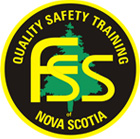Tractor Trailer Tips, Driver Injured: Seatbelt Slack
Hazard Alert
Drive Appropriately and Use Seat Belts Properly
A tractor trailer loaded with studwood had turned easterly onto Hwy. 8 from the West Dalhousie Road. The tractor trailer had travelled less than 1 km up a significant grade (the driver estimated his speed to be 50-60 km per hour) when the driver encountered an on-coming car, which swerved towards the centre line to avoid several deer that ran across the highway. The trucker tried to pull onto the shoulder to avoid the swerving vehicle and deer; however, the shoulder was soft. As he felt the trailer list towards the ditch, he powered the tractor in an attempt to right the trailer. He was unsuccessful, resulting in the trailer tipping over, pulling the tractor with it into the ditch. Due to the steep embankment (10 feet), the tractor was almost on its roof before it came to rest. The driver was wearing his seat belt and was injured during the mishap. The driver had to unbuckle his seat belt before crawling through the window of the tractor to escape. The driver of the car did not stop and most likely did not see the roll-over. The owner of a home adjacent to the accident scene called 911. The driver was taken by ambulance to the hospital.
Although the truck was believed to be travelling at moderate speed, the tractor trailer was travelling too fast to safely complete the evasive maneuver based on conditions at the time of the accident. Additionally, the driver was using a seat belt equipped with a “Comfort Latch” slack adjuster, which perhaps allowed too much slack between his chest and shoulder belt. The latch mechanism carries a warning that states, ” No more than 1″ slack between chest and belt.” Excessive slack in the belt could significantly reduce the effectiveness of the seat belt and may have resulted in the severity of injuries sustained in this accident.
Recommendations to Prevent a Recurrence
Drive at an appropriate speed for driving conditions. Always use seat belts and/or belt slackening devices in accordance with manufacturers’ recommendations.
